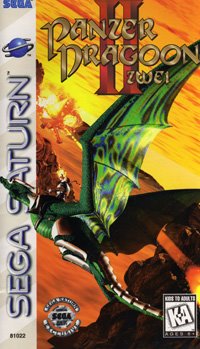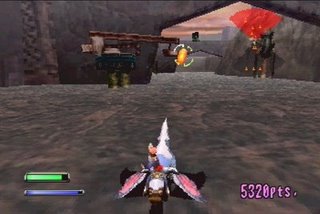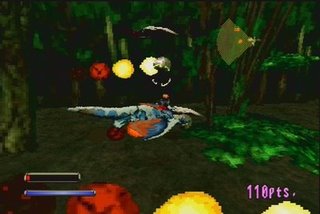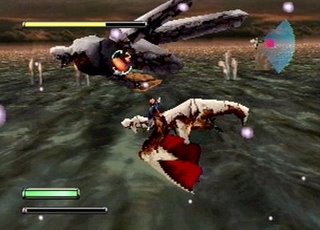Panzer Dragoon II Zwei
 The follow-up to Panzer Dragoon, Zwei is actually a prequel, taking place several years before the events of the first game. It follows Lundi, who, despite local law to the contrary, decides to raise a mutant creature that has a blue-white light emanating from its neck. Besides the glowing orb, Lagi also has wings, which Lundi reckons will allow the beast to fly someday and ultimately prove that all of the morphed creatures are worth keeping around. A year later, while training Lagi to fly, a colossal ship passes overhead and Lundi can only watch as it destroys his village. Swearing revenge, he grabs a laser, hops on his mutant dragon, and begins his quest.
The follow-up to Panzer Dragoon, Zwei is actually a prequel, taking place several years before the events of the first game. It follows Lundi, who, despite local law to the contrary, decides to raise a mutant creature that has a blue-white light emanating from its neck. Besides the glowing orb, Lagi also has wings, which Lundi reckons will allow the beast to fly someday and ultimately prove that all of the morphed creatures are worth keeping around. A year later, while training Lagi to fly, a colossal ship passes overhead and Lundi can only watch as it destroys his village. Swearing revenge, he grabs a laser, hops on his mutant dragon, and begins his quest.
PDZ kicks in where the original left off. Instead of easing players into the action, there's a quick warm-up and then they're thrust into the thick of it - not a bad thing by any stretch. The game seems faster, more furious, and much more frenetic than its predecessor. Game mechanics are the same, for the most part, with a few small tweaks along the way. The dragon loses its ability to roll, but instead has gained a "berzerk" attack. A bar slowly builds as the dragon fires shots, and when there's enough energy, a barrage of shots are unleashed, targeting everything on screen and devastating surrounding enemies. Now, instead of flying the entire time, certain portions of the game require the dragon to walk on the ground, adding a bit of variety to some levels. Enemies still litter the landscape, but they seem to attack from the back and the sides more often than in the previous game.
Quite possibly the best addition, though, is analog control. Taking advantage of the Saturn's 3D control pad, the game feels much more precise and the on-screen cursor moves even faster. Unfortunately, a bug forces the game to set off the berzerk attacks every time the view is rotated, unless the X button has been mapped to be inactive. Rotation is still controlled by the L and R buttons, but now the screen will rotate, albeit slowly, if the cursor reaches the side, so no more being locked in at exactly 90 degree intervals.

Levels are designed quite well, with each having a distinct environment. The game begins at night, running around through Lundi's destroyed village, avoiding enemies and chasing after the gigantic ship. After traveling through the desert, the duo eventually reach forests of episode three - a highlight of the game - where trees fill the landscape and light pours through openings in the treetops. Cave-like corridors are traversed in episode four to reach the calm waters below - a compelling sight despite the dated graphics. Later levels include a snow covered world and ultimately, the mammoth ship responsible for the destruction of Lundi's village.
Zwei, like the original, is fairly short at only six full episodes, which, although not too hard, provide a few challenges along the way. But just completing it doesn't mean you've seen the entire game. Several levels now have multiple paths that can be taken - some harder, some not as hard. Not only does it require multiple plays to see each level fully, but which path you take affects the outcome of the game as well.
At the end of each episode, points are acquired based on enemies destroyed, levels completed, and the route taken. These points are used to determine the dragon's evolution - how much it grows, if it grows, and what form it will take. As the points add up, the dragon morphs into a new form, becoming more powerful, gaining different attacks and increasing its ability to take damage. There are several endings, all based on what form the dragon has reached when the game is completed. To manage it all, a save feature is added in place of the arcade-oriented credits system imposed to drag out the original.

If the game is completed in one sitting, then Pandra's Box opens up. Even though it looks like a misspelling of Pandora's Box, I'm pretty sure it's intentional, taking the first part of Panzer (Pan) and Dragoon (Dra), and then throwing them together. What is it? Cheat mode. Though the game can't be saved with the box options turned on, there's a lot that can be played around with. Different weapons, berzerk attacks, game difficulty, dragon evolution, start level, etc. are available here. The options add replay value, giving yet another reason to go and play through one more time.
Not all changes are just for playability. Graphics have been tweaked this time around, as well. By far the biggest improvement is the increase in frame rate. The first game ran at a locked rate that was under 30 frames per second. The result: Things felt really slow. That's not the case in Zwei. The faster frame rate is worth it, even if there are a few trade-offs, such as a less detailed dragon and more sprite-based objects.

Music is different in Zwei, too. PD had a Redbook audio soundtrack that was part orchestral and part synthesized. The orchestral songs, with the horns and strings, really gave the game an otherworldly feeling, while the synthy beats pumped rhythm into the boss battles. This time around, everything is being cranked out by the Saturn's hardware. At first, I was disappointed, since the songs don't capture the atmosphere quite as well as the original tunes did and the sound quality itself is a small step down. As time went on, the tunes started to grow on me. For the most part, they're pretty good, but a couple compositions (like the first track of Episode 6) seem out of place - less like the world of Panzer Dragoon and more like typical videogame music of the era.
All things said, the game is very enjoyable, and improves in almost every aspect of the original. The action is more intense and the levels are larger, rewarding the player for spending more time in them. The additions of dragon evolution and Pandra's Box give even more reasons to revisit the world of Zwei. PDZ is a fine addition to any Saturn owner's collection.
9/10
8/9/08
